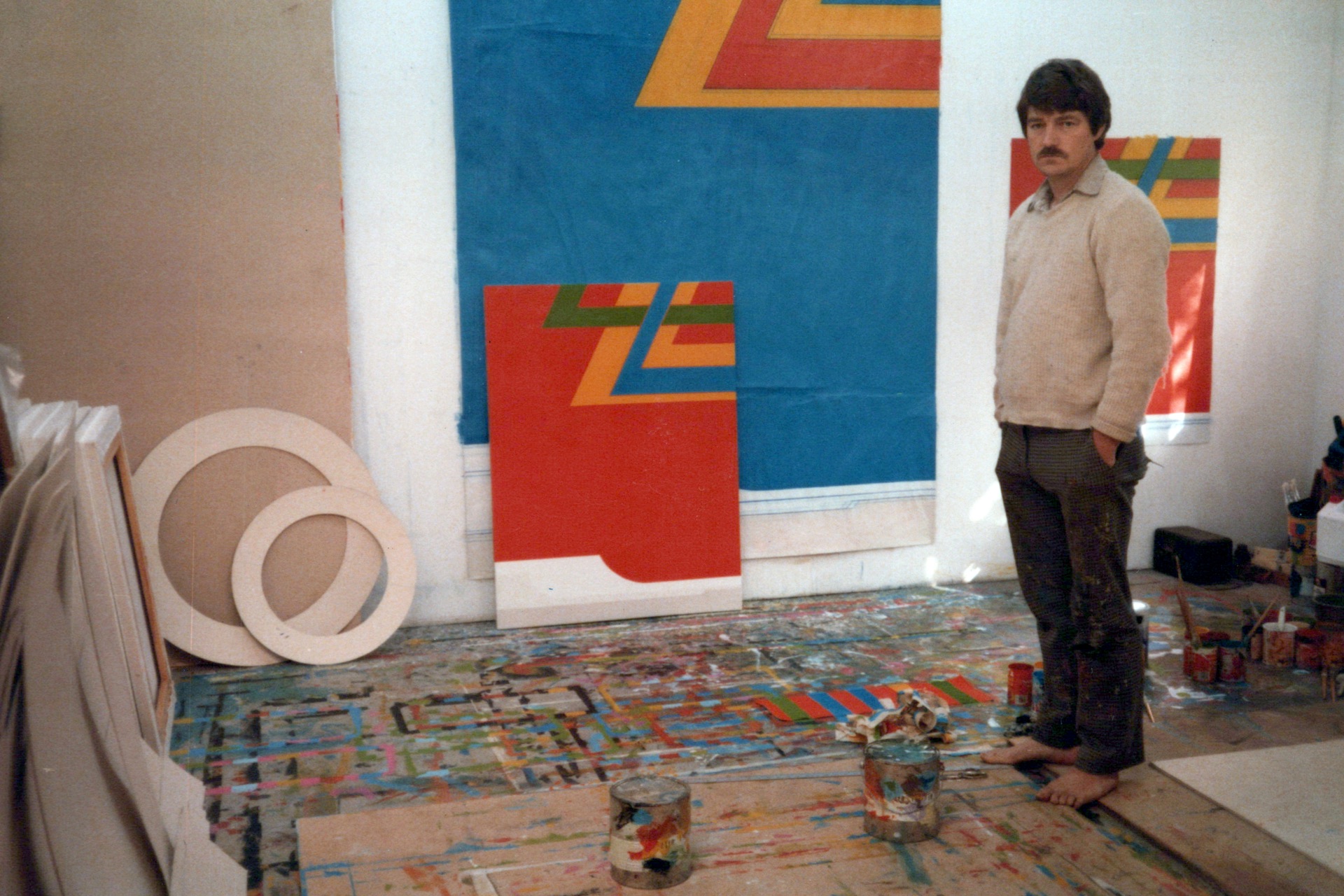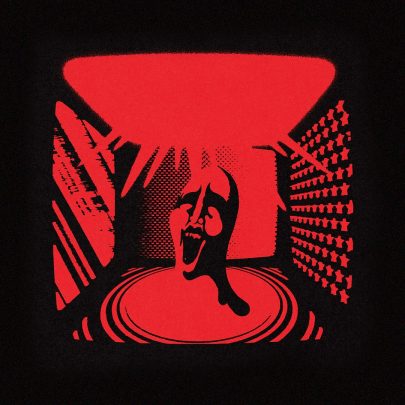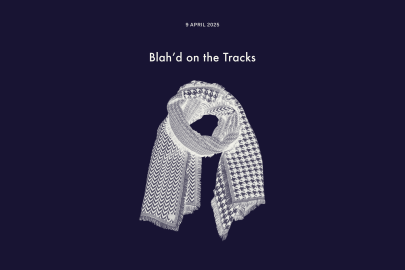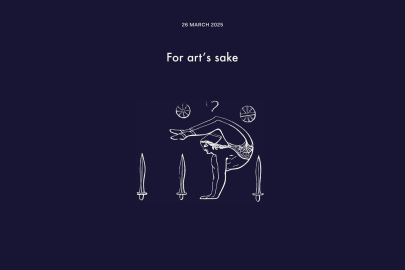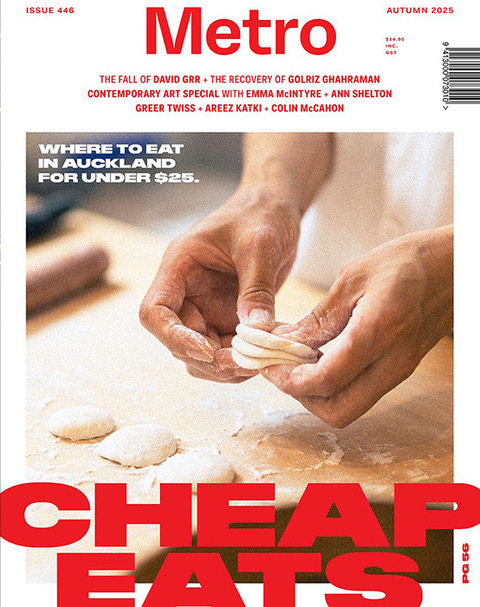Apr 9, 2024 Art
The auctioneer holds the gavel in his palm, its handle hidden up his suit sleeve. An object used in courtrooms, boardrooms and auction houses, but rarely elsewhere, the gavel hangs poised as the auctioneer narrates this art sale like a horse race: “A piece of iconic New Zealand art, ladies and gents, going once — I’m with you, online bidder — going twice — I’m looking for 100, a mere 100 for beauty, and—”
* CRACK *
“—sold! Pending approval by the vendor.”
I had never been to an auction before. The ‘art world’ is probably better understood as a series of worlds — sometimes intersecting, though more often than not oblivious of one another. I had come along to Webb’s auction house hoping to “feel the market”, as one auction-world figure described it to me. The gavel came down on the painting hung behind the auctioneer: Ian Scott’s Small Lattice No.134 (1986), its title implying at least 133 others like it. The auctioneer made a note at his podium — $25,095, a figure $7000 more than the low estimate — and for a moment the painting became the latest successful sale in a market worth around $60 million a year in Aotearoa New Zealand.
He must be a rich man, this Ian Scott.
Chris Corson-Scott meets me in a studio adjoining a massage parlour in Ponsonby. The neighbourhood used to be filled with artists; now, one street of villas in the gentrified suburb is worth more than the annual yield of our secondary art market. The studio is filled with printers, books and artworks and has an area splattered in paint where Corson-Scott’s partner works on old frames bearing the name of his father, Ian. Families matter to artists (as they do to us all) and soon they will matter in the country’s auction houses, as a new artist resale royalty comes into effect in late 2024, giving artists and their estates 5% of the sale price for any of their work sold at auction.
Scott, it turns out, did not make a lot of money before he passed away in 2013. The reasons are complicated. There was the dealer gallerist who “lost the faith” in the 1980s, the cold shoulder from abstract painters who felt he betrayed the calling and, perhaps most of all, Scott’s own relentless creative spirit — a precious quality, though not always on the auction block. Corson-Scott, who is now the custodian of his father’s artistic legacy, says for decades his father’s work didn’t do well at auction, “almost entirely because of his drive for experimentation, which manifested in stylistic changes”.
Serious though he was — he worked full-time as an artist from the 1960s till his death — Scott lived in the twilight days of amateurism. The value of contemporary New Zealand art ascended to meaningful sums only from the late 1990s onwards; previously, few artists were able to make a decent living from their artwork. And while artists have never been on the auctioneer’s payroll, the secondary market has long mattered to the artistic community, as sums on the primary art market (and in artists’ pockets) can be contingent on values dramatically enacted through the auction houses. In the case of Ian Scott, his work is posthumously represented by Michael Lett gallery, meaning prices achieved by his dealer and paid to his estate are influenced by those set at auction. At the most extreme end, there’s Michael Parekōwhai, whose future work enjoys the market’s “confidence” after the record-setting $2 million-plus achieved at auction in 2021 for his 2011 sculpture A Peak in Darien. Some artists might never have reason to care about the auction world — their work may be ill-suited for auction, or their patronage found elsewhere, such as in public funding bodies or tertiary teaching positions. Still, the art market matters, both in its primary and secondary forms, if only to uphold the fragile belief that art has value, monetary value.
As a working artist himself (his photographs are held across major public collections), Corson-Scott speaks of his father’s life with a practitioner’s knowledge, though the conversation remains deeply personal. “It’s part of your livelihood as an artist — what sells or doesn’t sell at auction has consequences.” Corson-Scott recounts an experience of poverty shared by many artists and their families. “For my father it was literally a handful of collectors who kept him afloat in the moments when his changes in direction saw the market turn its back on him.”
Wellington-based collectors Jim and Mary Barr purchased one of Scott’s paintings at a charity auction in the 1980s, “incensed” at the low price. Despite their relatively modest means — they themselves work in the art world rather than being investment bankers or property moguls, and say they have an average variety of “boomer wealth” — the Barrs have acquired one of the most important collections of New Zealand art over 50 years of active and astute collecting. When I talk to him, Jim doesn’t sound particularly excited about the lauded resale royalty. “The New Zealand government were forced into doing it [in 2022] because of a free trade agreement with the UK. They didn’t finally do it after years of consulting with us all — it got done to them!”
Resale royalties are already established practice in 80 other countries, and the idea is at least 140 years old, dating back to the sale of Jean-François Millet’s painting L’Angélus for 553,000 francs, less than 30 years after it first sold for 1000 francs. The extraordinary figure led to a public outcry when the poverty of the dead artist’s family was discovered. In New Zealand, the Equity for Artists lobby group invoked these same narratives of artistic iniquity in its 2021 campaign for a royalty. While that push was not what eventually achieved the royalty, the group’s infographics were widely shared on social media, publicising the zero-sum gain of auction houses against artists.
The Barrs watched the emotive campaign play out, though unlike most collectors, they have had a long-term policy of paying artists half of the money they receive when they on-sell an artwork in their collection. This is not a common practice, and leaves the newly legislated 5% looking weak. Eager to dodge praise, Jim explains: “There’s no morality involved in what we do. We just thought it was fair, basically.” Together we mull over the word ‘fair’ and agree that it rarely manifests in the way common sense suggests it might. “I don’t think you can convince people of fairness,” Jim says, “can you?” The Barrs certainly tried, hosting a seminar for collectors at the Dowse Art Museum in Lower Hutt in the 1980s to highlight ethical practices in the secondary market. “It was a farce,” he says. “All the collectors were there. And the idea of artists getting a return on sales just seemed wrong to them.”
Jim Barr suggests that we might have expected more from the artist resale royalty. “Maybe there would be something to celebrate if they made it 10%, or even the equivalent of GST — that would be fair.” The fact that it’s happening at all is what’s important to Corson-Scott. “An artist’s family shares their struggles, and are the support that allows the art to happen, so there’s definitely justice to a resale royalty helping the family after an artist’s death.” Like copyright, the resale royalty will apply for 50 years after the death of an artist — an important detail, as the end of life generally marks a macabre rise in prices, with the product line now finite. Corson-Scott says that in a perfect world, “the royalty would also be higher for lower-priced work or where the artist is alive. As it stands, it’s going to mostly help the most valuable artists at auction, which sadly is often not artists during their own lifetime.”
“Being a good collector is seeing the value in something beyond money. It’s saving things that are overlooked.” Corson-Scott speaks these words surrounded by his own collection of pottery. He tells me how upsetting it is to receive pots that were poorly packaged for freight, the shards of important cultural heritage found on arrival. “Value is a complicated thing,” he explains, with downcast eyes. “Art generally only gets protected when it’s perceived to have monetary value. I saw it unfold so directly with my father’s work. When the work wasn’t valued as much, it got damaged so much more often, but as it’s perceived to be more valuable, people look after it and treat it in a totally different way.”
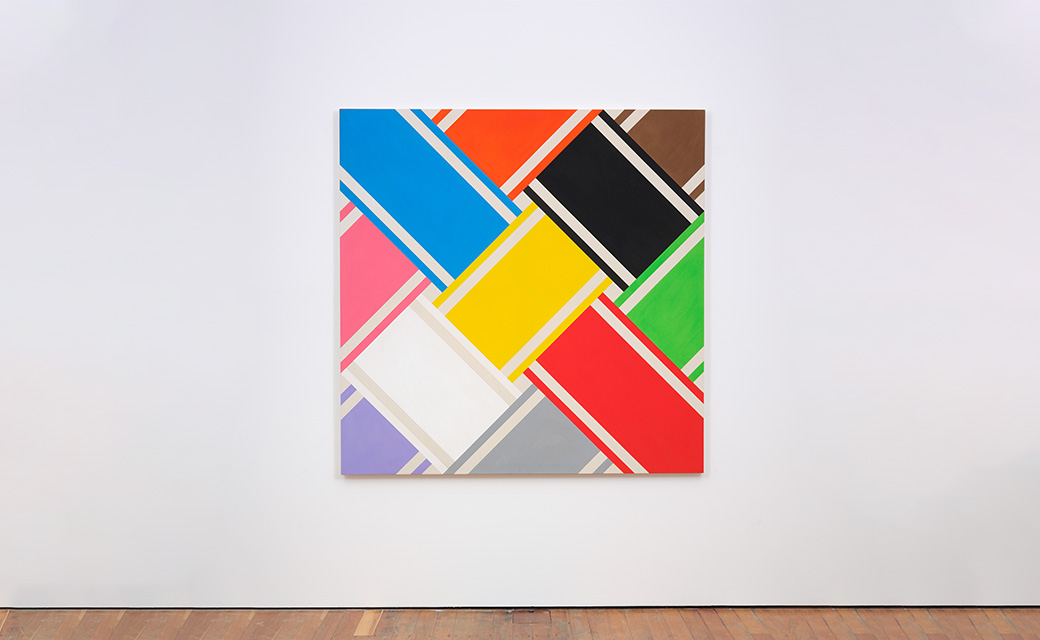
Ian Scott, Lattice No. 70, acrylic on canvas, 1720 × 1720mm
The intersecting primary colours of another Ian Scott lattice painting sit in the cluttered office of Art+Object, an auction house recognised for galvanising the country’s contemporary resale market when it was founded in 2007. Scott’s painting is one of many pieces stacked up against one another, unsold or soon to be sold, suspended in the transit of the market. I look closely at the lattice and wonder if it might serve as a map of the issues I’m pursuing — artists, gallerists, museums, auction houses and collectors, distinct and interwoven. Leigh Melville, the co-director of Art+Object, pulls an envelope from her dog’s mouth as she explains, “We have grown quite a unique beast in this country — the sale of contemporary art at auction. Not every country has such a strong resale market for works that are five to 10 years old.” While our Australian neighbour has a significantly less valuable secondary art market relative to its total size, it also has its Cultural Gifts Program, which facilitates tax subsidies for artworks gifted to public collections. The programme effectively provides a non-auction pathway for artworks after primary sale, a public-good incentive plainly lacking in Aotearoa.
Melville helps me understand the precipitous rise in the New Zealand secondary market in recent years — increasing from a total of $31 million in 2020 to more than $60 million a year in 2021 and 2022. The explosive growth correlates closely to Covid-19 and our closed borders, meaning wealthy New Zealanders, unable to holiday overseas, had more disposable income to spend on art. “[Just prior to the first lockdown, in March 2020], we quickly were able to adopt the technology and take our auctions online… We discovered that people were just as happy to stay at home, drink their own wine, and swipe.” The digital transition was not an unalloyed good, says the auctioneer. While her market has doubled since 2020, something is missing. “Very quickly, our auctions have become less about being in the room. Some of the magic has been lost.” I think of the gavel, the auctioneer’s sleight of hand, and recall that there were barely 10 people witnessing the market’s performance at Webb’s on the night I was there.
As I ask questions about the market, Melville is keen to address the resale royalty. Her “cottage industry” (as one auction-world figure describes it) is feeling singled out. “What other laws are there that pertain to such a small group?” Art+Object co-founder and former director Hamish Coney concurs. “If you describe it as an industry, then it is an industry that has five businesses in it, that employs 15 to 20 people. The dairies on Dominion Rd employ more people than the auction houses of Aotearoa.”
Coney, now retired from the trade, is a willing advocate for his former profession, and puts the 5% figure in context for me. “Let’s say that the average commission for sale at auction” — known as the buyer’s premium — “is around 27%. What you’re asking the industry to accept is an additional revenue line that equates to almost 25% of their revenue line.” Few businesses welcome new regulation, even fewer levies on their trade. Coney and Melville say there are issues with the breadth of application of the royalty — in particular, its lack of engagement with other avenues of secondary sale. “While I don’t have a problem with the resale royalty,” Coney declares, “all outlets for secondary sale should be asked to pay it. The royalty should apply to dealers [brokering secondary sales], and it should apply to Trade Me.
“The artist community had a legitimate grievance, and the royalty is the morally right thing to do. But it is not going to raise a lot of money for living artists, and it might have some unforeseen effects on the wider art market,” he goes on. The implication for the primary market has not been properly appreciated, adds Melville. “The primary market hasn’t taken it seriously enough. In all fairness, this should be explained at the point of purchase for future sales, and it’s a bit of a downer to say, ‘Just so you know, here are the rules’.” There’s the word again, fair — Coney and Melville seem to have a different model of fairness than that proposed by Jim Barr.
Both Melville and Coney direct my attention to their counterparts in the primary market, a somewhat mysterious professional group known as art dealers or, as they often prefer to be called, ‘gallerists’. Dealing in art is a notoriously opaque profession, associated with hidden shopfronts, wealthy clientele and shrouded influence within the art world. While auction house numbers are public and published annually, providing a barometer for the art market more broadly, the value of the primary market is anyone’s guess. “Unfortunately, nobody really knows,” shrugs Coney. “Why don’t you call the Art Dealers Association of Aotearoa?”
He and I both know no such thing exists. Dealers are notoriously competitive as a group, even downright contemptuous of one another. “There is a higher degree of enmity between dealers in the art world than in any other industry I have worked in. And less collegiality than any other industry that I’ve worked in,” Coney says. The acrimony may seem harmless — even beneficial, if dealers are competing to do better for the individual artists in their ‘stable’ (the strangely equestrian term used to describe a group of artists represented by a dealer). The downside is that the roughly 55 commercial galleries rarely, if ever, articulate a common position. “Every other industry seems to have been able to put aside its individual competitive position to be able to come together and advance the causes of that industry,” says Coney, “which, in this case, is in the interests of artists.” For instance, a group of gallerists proposed a kind of ‘fair trade’-style certification for the sector a few years ago, but they couldn’t find agreement on the logo or its meaning.
Melanie Roger has worked in the commercial art world for 30 years, heading her own gallery for more than a decade, and she knows how the profession is perceived. “We’re considered to be the dirty side of the art world,” she says. “That’s a real misunderstanding of what we do. We advocate for artists, we manage their careers with a long-term view.” Along with the direct remuneration to artists, the depth of relationships is one of the distinguishing factors of the primary art market. “The relationship with your artists is like a marriage,” she explains, and the dealer often assumes complex pastoral care for their artists, whose lives are rarely simple and whose after-death existences can be even more complicated.
Roger has her own bones to pick with auction houses, mentioning the sale at Webb’s in August of a Bill Hammond painting, Melting Moments 1, that set a record for the artist. “That’s $1.7 million that isn’t going into supporting galleries or artists.” It’s a rub that’s hard to avoid. While the primary art market might be overridden with infighting and dubious professionalism, it does pay artists (at least, in theory) — they usually receive 40% to 70% of an artwork sale price. It is the dramatic discrepancy between these figures and the current 0% at auction that makes redress of the secondary market via the resale royalty feel urgent.
Other forms of redress also exist, however, such as in the quasi-socialisms of northern Europe. In Norway, a 5% ‘art tax’ is applied to all art sales and transactions (except private ones), the money going towards broadly accessible grants for artists. It’s a non-discriminatory way of increasing funding for artistic development, and as a surcharge, resembles the ‘gift aid’ contributions of charity organisations.
Applying such a system here would be to solve the problem of one tax with another tax, of course — an approach that many within the sector would oppose. And where there’s a tax, there are always ways to avoid it. “I sometimes wonder if the people who framed this legislation think nothing will change. One of the things that could potentially happen is that more private sales will take place,” says Coney, completing his cautionary tale with “be careful what you wish for”. Many in the art world espouse progressive politics, but there is little desire to introduce new regulation to the carnivalesque art market.
Last September, another lattice painting by Scott appeared in a show of his work, Asymmetrical Chevrons, at Michael Lett, one of the most prestigious commercial galleries in the country. I found the unfurling, late-period lattice not in the vaulted interior, but in a discreet corner near a staircase. “The prominence of those [lattice] paintings is partly because of McLeavey’s taste,” explains Andrew Thomas, co-director of the gallery. He’s referring to the legendary Wellington dealer Peter McLeavey, who was representing Scott during the period he made the lattice works. “McLeavey saw Ian as ‘the Lattice painter’,” remembers Corson-Scott, who catalogued the fullness of his father’s oeuvre in the photograph My Father’s Studio, Three Months After His Death From Cancer (2013). “McLeavey would have been happy if he just made lattices forever.”
These days, as Scott’s representative, Michael Lett continues to sell the artworks belonging to the estate, helping to manage Scott’s artistic afterlife and keeping a judicious eye on the prices being achieved by his works at auction. “The secondary market alone doesn’t generate value,” explains Thomas. “There has to be more fuel than that. Ian holds an undeniable position in this country’s art history, but value in market terms is created when different cornerstones of the industry are all firing together.” Thomas and the gallery intend “to keep fanning the flames [around Scott’s work]. Not just to build the market but to cement his legacy.” While auction houses are adept at monetising the legacy of an artist’s long career, dealers have to build it in the first place and keep it burnished, an altogether more complex task that also involves cultivating an artist’s reputation. As Jim Barr puts it: “The dealers shape everything, really.”
“I tend not to engage much with the auction houses,” explains dealer Tim Melville (Te Arawa, Te Ātiawa) of the eponymous gallery in Auckland, “but if I see something that was bought from my gallery, I’m always curious to see how it performs on the secondary market.” He notes that auction prices can be wayward and anomalous, affected by the particular passions and predilections of whoever happens to be in the room or bidding up from afar: “I usually take auction prices with a pinch of salt.”
As one of the first Māori gallerists in the country, Melville is critical of the secondary market for the way it reflects wider prejudices. “Māori artists’ work has been undervalued, stigmatised and set apart from the market for a long time,” he says. Making reference to how “ridiculously” cheaply — until recently — one could buy the works of senior Māori artist Sandy Adsett and almost-as-senior painter Emily Karaka, Melville says, “It’s not always a case of artists needing to ‘come into their own’. There has also been purposeful neglect, along with a Eurocentric assessment of what counts as important New Zealand art.
“There aren’t many Māori working in the commercial art world,” he continues, “and let’s face it, the people who bid at auctions are pretty much all non-Māori. But the more that indigenous artists’ work is seen in dealer galleries, the more it will be seen at auction, and the more the market for their work will broaden and deepen.”
Corson-Scott agrees, noting that the persistent undervaluation reflects “small-mindedness, if not simply racism”. However, both artist and gallerist say that things are improving slowly, highlighting the influential public exhibition Toi Tū Toi Ora at Auckland Art Gallery in 2020–21, a moment that appears crucial to Melville. “We were introduced to the work of 110 Māori artists, many of them unfamiliar but who had been here all along.” The ‘art market’ does not stop at the point the commercial galleries end — in fact, our major public collections reflect the tastes and opinions of dealers, who may fall in and out of favour with curators and acquisition committees. Largely in tune with the market though it is, the public sector can pose curatorial advocacy that feeds back into shaping the market, nudging it towards that which is “hiding in plain sight”, in Melville’s words.
Back at Michael Lett, I pitch the ‘Association of Dealer Gallerists’ idea to Thomas, suggesting it might see greater advocacy and collectivity within the sector. “In a market that is really very small,” he replies, “like New Zealand, there is perhaps too much competition for something like that to exist in a way that would be helpful.” I might put it another way: there is not enough belief across the sector in one another’s work, in one another’s artists. And Thomas does agree that belief is key. It is part of what keeps him “captivated” by the art market — a curious choice of words, in that ‘captivated’ dovetails with ‘captivity’. “It’s partly to do with the ambiguity of [the market], the mystery of it,” explains Thomas. “The creation of value around things that — for a lot of people — have no value. The collective sense of belief in something that can create and maintain that value.”
It might sound ethereal, but the fascination with value creation is a key driver for the ‘trader collectors’ who sustain the art market. The art market is a market for people who love markets; a place where value is always a machination. The financialised assets of this market can’t be understood without the social, the cultural and the discursive. Dabbling in buying, holding and selling art is a leisure activity for these consumers and attendants, a playground of frivolous behaviour. Occasionally — if you’re lucky — it also involves good art.
Conjuring ‘good art’, however, is harder than it sounds, and often requires avoiding the larger market in favour of elite art-world players and their discreet clientele. Simon Bowerbank, once part of the auction world at Webb’s and Bowerbank Ninow, now director of Whangārei Art Museum, knows the tensions and contradictions of the art market. He offers a surprising hypothetical: “If I wanted to make a lot of money selling art, I would open a gallery that just focused on ‘bad’ art: decorative and easily digestible works that don’t require any thought on the part of the viewer or challenge them in any way. It’d be a terrible art gallery, but probably a good business.” I ponder Bowerbank’s theory, then remember a gallery on Quay St that sold reproductions of novelty dog paintings for tens of thousands. The pups are all but worthless on the secondary market, underlining the tension between ‘appeal’ and ‘value’.
Bowerbank, sporting the long beard of someone who’s let his hair down in the public sector, knows that “the closer you are to retail, the further you are from contemporary art… The most serious and committed elements of the primary market don’t want to look retail-friendly, because their aim is to shepherd the development of the artistic conversation.” All that shepherding takes work, Bowerbank knows. “The main difference between the secondary market and the rest of the arts sector is that auction houses aren’t generating culture. If I am being generous, I would say that they are reflecting it by presenting a selection that appeals to the tastes of their customers.”
The art world is a complex catch-all of artists, writers, educators, administrators, gallerists and communities cobbled together. And together, they create that most important of things — culture. Auction houses package that low- and unpaid labour and profit from it, as a middleman dressed up as a connoisseur. Bowerbank acknowledges the problem. He knows that “the financial value of artworks on the secondary market is almost completely based on peripheral or ancillary factors”.
Peripheral, ancillary, human factors.
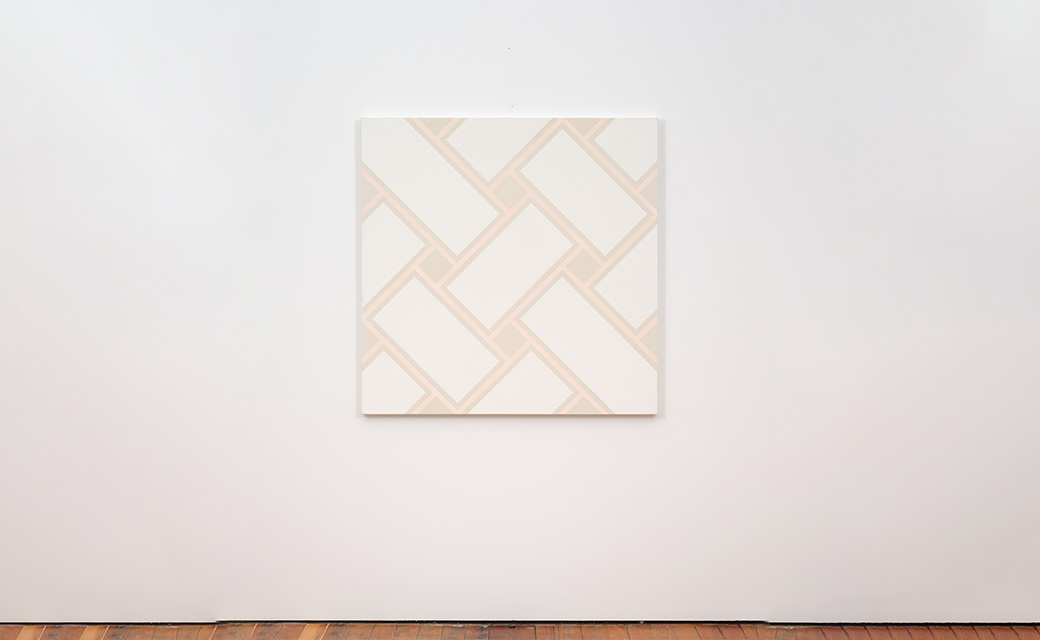
Ian Scott, Lattice No. 117, acrylic on linen, 1145 × 1145mm
Artists and their families aren’t the only people who have taken issue with the secondary art market. In recent years, some Māori communities have objected to — even protested against — the practices of auction houses. The grievances are numerous, and include the undervaluing of contemporary Māori artists, the continuation of ethnographic framing within auction houses, and the lack of consultation with iwi regarding the sale of taonga. Among the most sensitive of these issues is the sale of paintings depicting tīpuna figures, such as those painted in the late 19th century by Gottfried Lindauer.
The Bohemian artist exhibited and sold his portraits on Queen St, above the tobacconist and sporting goods store owned by his patron, Henry Partridge. He entered into complex relationships with his Māori subjects, and has retained more art-historical credibility than his more overtly racist contemporary, Charles F Goldie. Still, both artists count among the six-man ‘million-dollar’ club of New Zealand art (no women members, so far), and Lindauer’s portraits fetch the highest prices when depicting Māori. (When auctioned, his settler portraits are considerably less valuable.)
In March 2023, a Lindauer portrait went up for auction at the International Art Centre in Parnell, an auction house that seems to specialise in the works of Goldie, Lindauer and other 19th-century notables. The painting was of Harawira Te Mahikai (d 1886), a rangatira of Ngāti Kurukuru (a hapū of Ngāti Kahungunu) who signed Te Tiriti o Waitangi in Hawke’s Bay in June 1840. A curious and interesting subject to some; to others, a manifested ancestor vested with mana and wairua. The barrister representing the hapū, Echo Haronga, talked me through the problem of auctioning off portraits of tīpuna. “This issue cuts to the heart of the differences between Māori and Pākehā worldviews… From a te-ao-Māori-informed perspective, it is incomprehensible that an individual might privately own, and profit in capital gain from, the physical representation of tīpuna,” said the lawyer.
“That’s a tricky one,” says Coney, a reo learner who has previously worked with the Kīngitanga to value their collection. The auctioneer knows the fraught issue is not easily reconciled, given that the auction houses stand to make huge sums from the six- and seven-figure sales of these works. The director of the International Art Centre, Richard Thomson, sounds less torn. “They’re artworks, at the end of the day. They’re not actually people.” And while citing the “respect” due all portraiture and “absolute privilege” in selling the artworks, Thomson thinks the facts are simple. The market offers access, and while “it’s wonderful when the family can raise funds to buy [a painting]”, he says, ultimately “it goes to whoever comes up with the cash”.
“These paintings are taonga to us. They’re sacred images,” explains Joseph Gillies, an elder within Ngāti Kurukuru, who before the auction approached Thomson on behalf of the hapū. Gillies asked the auctioneer to look into the eyes of his tipuna. He chose to make his case there, in the space below Te Mahikai’s brow. The portrait later sold for $1.3 million to an unnamed private buyer.
“They are business people — all they care about are numbers,” observes Gillies of the professional class within auction houses and their collector clients. “To them, a Lindauer painting is a chattel, an object, a secular item for sale with no spiritual value whatsoever. That’s the reality. For all I know, the person might like the piece, might consider it an outstanding painting. But they have no spiritual relationship with that taonga.”
While the Protected Objects Act 1975 offers a framework for the regulation of significant objects in Aotearoa, the main effect of the legislation is to restrict significant objects from leaving the country and does not comment on sales within the domestic secondary art market. Gillies weighs in on the immoral legalities: “How many Māori laws are written in the New Zealand statute books? Nil. Nought, zilch, slant, nix, kaput, zero, none. We have always applied Westminster law to Aotearoa. It has been the lie of the land since 1840.”
Bayden Barber, the chair of Ngāti Kahungunu’s mandated iwi organisation, keeps a close eye on the auction houses, though he isn’t in the market for art. “I need to know,” he says, staring out the window to the valley of Waimārama, his steely eyes not unlike those of his four-times-great-grandfather Te Mahikai. “I see taonga that are going up for auction. I hope that whānau around the motu are aware. I keep an eye out for Ngāti Kahungunu, but also for other iwi,” Barber tells me, gesturing a phone call near his ear. “‘Did you know your tipuna is up for auction?’
“Māori culture has quite a unique view on taonga. Portraits are just like a person to us,” Barber says. “We look at that portrait” — he points to a printout of Lindauer’s painting of his tipuna — “and we see our ancestor, and everything around that ancestor comes into play — their children, their descendants, their feats in battle, the women they married, their kōrero.
“The Tākitimu waka which bought most of the Kahungunu ancestors landed just down on the beach there,” Barber gestures down the valley to the white sands of the bay and whale-like curves of Te Motu-o-Kura beyond. Waimārama Marae is a short walk from Barber’s house, and at its heart is Taupunga, a wharenui named for the anchor on the Tākitimu canoe. The interior is lined with hundreds of faces, whānau and tīpuna reaching back to Te Mahikai, and before him, Tiakitai, a leader of great mana. “How do you maintain the mana of an ancestor like this? Well, they sit in their own house, or they sit where their descendants can access it.”
The iwi contemplated raising funds for the tipuna to come home, and even approached the International Art Centre for the right of first purchase. The estimation of upwards of a million dollars came at a bad time. “We’d had Cyclone Gabrielle, whānau who had nowhere to live, and people struggling to survive in the cost-of-living crisis.” They even called Te Papa Tongarewa, our national museum, to see if they were in a position to acquire the portrait. Barber remembers the call: “Hey, you got a spare million dollars?”
Matariki Williams, former curator of mātauranga Māori at Te Papa, meets me at our largest public art collection, at Auckland Art Gallery Toi o Tāmaki. “Most public institutions don’t have that budget,” Williams explains, about the sum the portrait of Te Mahikai sold for. With museum and gallery acquisitions budgets largely unchanged since the 1980s, put simply, the state has been priced out of the market, and lacking Australian-like incentives to tempt collectors to donate work, our collections are at risk of stagnating. The situation, for Williams, is a concern. “If taonga go into private collections, what does that mean for our art history? How will we ever get to engage with those works again?”
Williams and I take a walk through the gallery, looking for answers among the art and taonga held in public trust. As a social historian, Williams knows that “one artwork can convey huge histories”. She shows me sculptures by Arnold Manaaki Wilson, remembering the great educator interred within the artwork. Williams points at the greenery on the base of one of Wilson’s sculptures. “Look! I just love that it’s covered in lichen.” The organic matter seems a rebellious affront to the usual edicts of conservation that govern galleries and museums. Amid the climate-controlled, insurance-burdened confines of public institutions, the best art insists on its own story, its individual passage through the world.
In the next room, we encounter the Romantic hues of Lindauer’s portraits, meeting the rangatira suspended in the dream-swept horizons. Williams looks closely at the gilded frames and the tīpuna contained within. “There was an incident a few years ago in which a fake Lindauer went on the market,” she says. “And after it was detected, the fake was given to the descendants. The whānau don’t care that it is a fake, they care that it is their tipuna, and they love that painting.” It’s a telling point, and reassuring considering that the International Art Centre has provided Ngāti Kurukuru with a couple of facsimiles, copies, that are perhaps more treasured than the original Lindauer painting in the true life they can summon. “There are a lot of replicas in marae,” explains Williams. “It’s not the facsimile that is important, it’s the subject. The authenticity is somebody else’s concern.”
Joseph Gillies and I meet at Westfield Newmarket, or more precisely at the kōhatu mauri placed at the edge of the shopping centre. The stone marks a historically significant meeting place for Māori and Pākehā alike, but I also wonder if Gillies has chosen the mall location to contemplate what he describes as “objects of the capitalist ethic”. The elder dismisses the idea, waving the building away. “It’s a monstrosity. I would love to send everyone home on full pay and create a public park.” On the plaque, I read the verse that Gillies composed for the god stone. There the poet and former prison rehabilitation worker acknowledges the mauri of Ngāti Whātua Ōrākei, who have mana whenua over that part of Auckland. The local iwi recently had their own run-in with the auction world, this time over the sale of mere by Sotheby’s. The international giant had failed to acknowledge the descendants’ “inextricable link” to the taonga, Ngāti Whātua said firmly, calling out the looting and treasure hunting that had alienated iwi from their artefacts.
Sitting silhouetted by the Coco Republic store, Gillies pulls a Ray White real estate brochure out of his satchel — evidence to be submitted in some higher court. “The value of humanity has diminished, whereas the value of property has increased,” he says, pointing an accusatory finger at a $2.6 million villa. “We have entered a time zone of diminished responsibility from the mid-1980s to the present day.” It’s a date that has come up repeatedly in my interviews for the Uneasy Money series, a moment at which the underlying mythos, the fairness of our society — imperfect though it certainly was — turned. Gillies insists that it’s all part of diminished responsibility, as tīpuna go for sale and shelter is turned into a financial portfolio.
The next item to emerge from Gillies’ satchel is a book of Lindauer paintings. His hand moves lovingly over the rangatira on the cover and he encourages me to look closer, to stare deep into the eyes the painter reproduced. “You can see the compassion. You can see the warmth. Lindauer got it right.” Turning the page to his ancestor, Joseph embraces the image, “through my breath, through my heart, through my blood, through my bone. My koromatua is alive in me.”
While that painting is also currently held by an unnamed private owner, Gillies is clear about the future, and hopes that, one day, “the taonga will come back to us”. There are grounds to believe that could happen, as our institutions and legal system make tentative steps toward incorporating principles of tikanga alongside Westminster and common law. “I think of when the Whanganui River was constituted legally as a living entity, as a living being, by its people,” says Gillies. “That is very sophisticated thinking, an example of where we could go, what we could do, a game-changer to protect taonga, natural and cultural.”
While it might seem far-fetched today, with a new government in power seeking to further entrench individual property rights, the art world — with its remit to experiment, to create — may be the right place to extend tikanga. Gillies seems to think so, and he holds out hope that one day his tipuna will come home.
I had set out to understand the secondary art market, to hear from the agents within how artworks and taonga are constituted in economic terms in Aotearoa. Thinking about what I had learned from the people I’d spoken to, some words from Thomson, that specialist auctioneer of Lindauer, came to mind. Despite his fealty to the art market, he’d acknowledged outright: “No one owns anything, we’re just custodians, really. It’s only passing through our hands.”
The words were spoken plainly, and for me they carried bittersweet potential. Enacting custodianship and kaitiakitanga could become a different way of relating to art and taonga in Aotearoa, away from the model of private ownership that currently governs our art market. After we’d talked at the mall, Gillies would sometimes call to check in on the story and remind me of the right and proper question: “What is the greatest thing in this world?” I wait in suspended silence for him to complete the famous whakataukī composed by Meri Ngāroto of Te Aupōuri. “He tāngata, he tāngata, he tāngata.” People, it is always the people. Art belongs to the people who offer it their belief, who imbibe its meaning. Everything else is the legal fiction of property.
No one owns anything. It’s only passing through our hands.
–
Images courtesy of the Ian Scott Estate and Michael Lett Gallery. Lead image: Ian Scott in his studio
This story was published in Metro N°441.
Available here.


